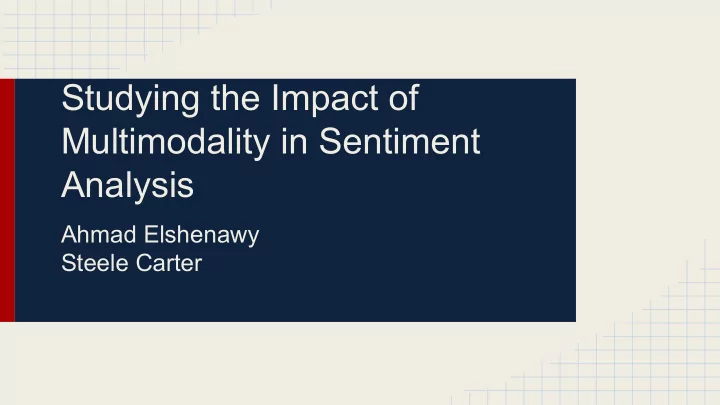

Studying the Impact of Multimodality in Sentiment Analysis Ahmad Elshenawy Steele Carter
Goals/Motivation ● How are judgments influenced by different modalities? ● Compare sentiment contributions of different modalities ● Use Interannotator agreement to measure objectivity of sentiment and ease of judgment ● Observe how results change for fine grained judgments of review chunks
Background/prior work ● Towards Multimodal Sentiment Analysis: Harvesting Opinions from the Web (Morency et al) ○ Built sentiment classifiers using features from 3 different modalities: ■ Text ■ Audio ■ Video ○ Created YouTube corpus of video reviews ○ Found that integrating all 3 modalities yields best performance
Corpus ● We created our own corpus of Youtube video reviews, consisting of 3-5 minute long book reviews. ● Originally 35 videos were found and analyzed, but the experiment uses only 20 videos. ○ corpus reduced primarily due to cost concerns ○ 6 positive, 6 negative, 8 neutral ● Originally video transcriptions were obtained via crowdsourcing ○ was way too slow, and way too expensive
Annotation ● Transcribed each video by hand ○ Labeled disfluencies (um, er, etc.) ● Also labeled our own evaluations of sentiment for comparison and spam filtering ● Added timestamps dividing transcriptions into chunks
Modalities We experiment on four different modalities here: ● Text only : typical in sentiment analysis, workers are given only a piece of text. ● ● Audio only : workers are given an audio-only piece of the review.
Modalities - cont’d ● Video only : workers are given a video piece of the review where the video is muted, and they are given no option to increase the volume. ● Audio/Video : a complete piece of a video, with sound and video intact.
Video Chunks ● Videos were annotated with timestamps, breaking up videos into ~20-30 second chunks, typically also demarcating new topics within the review. ● A HIT was designed where workers are presented with 5 of these chunks, and asked to judge the sentiment of that chunk.
HIT Design ● Experiment ended up needing 8 Mechanical Turk HITs. ○ One set of HITs for each modality. ■ Text only, audio only, video only, audio/video ○ One set of HITs for chunks vs whole reviews ● Required a lot of javascript and HTML coding ● Collected 10 judgments per video/fragment, paying about $0.15 per task. ○ 20 video HITs per modality ○ 21 5-chunk HITs per modality
Instructions
Pre-survey
Example of an Audio/Video Chunk HIT
Example of a Text Chunk HIT
Spam detection/prevention ● HITs with audio, ask workers to transcribe first 10 words ● Label Gold sentiment chunks ○ Discard HITs that disagree with Gold polarity (eg if Gold is 5, discard 3 but keep 5) ○ Issue: can’t label video only modality ● Compare submissions to average MTurk worker judgments ● Currently, spam filtration has caught 175+ spam submissions
Results ● In progress ● Results so far... experiment Audio Audio Full AV AV Full Text Text Full Video Video Full Fragments Fragments Fragments Fragments kappa 0.7704488 0.4029066 XXXXXXX 0.3512912 0.4193037 0.3348412 0.2079012 0.1747049
Potential Analysis ● Interannotator Agreement ● Agreement between modalities ● Compare to Gold ● Compare Chunk deviation from full video sentiment judgment
Reference ● Morency, Louis-Phillipe and Mihalcea, Rada and Doshi, Payal. Towards Multimodal Sentiment Analysis: Harvesting Opinions from the Web, Proceedings of ICMI '11 Proceedings of the 13th international conference on multimodal interfaces, p. 169-176.
Recommend
More recommend